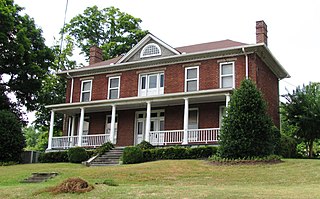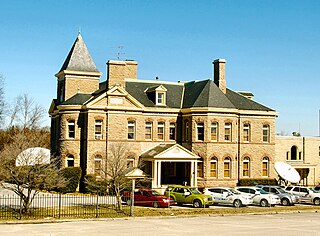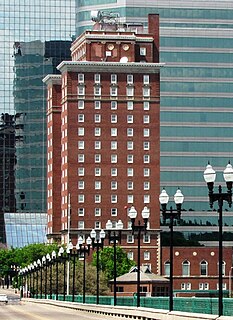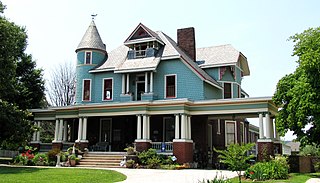
George Franklin Barber was an American architect best known for his residential designs, which he marketed worldwide through a series of mail-order catalogs. One of the most successful domestic architects of the late Victorian period in the United States, Barber's plans were used for houses in all 50 U.S. states, and in nations as far away as Japan and the Philippines. Over four dozen Barber houses are individually listed on the National Register of Historic Places, and several dozen more are listed as part of historic districts.

Sequoyah Hills is a neighborhood in Knoxville, Tennessee, United States. It is located off Kingston Pike between the city's downtown area and West Knoxville. Initially developed in the 1920s, Sequoyah Hills was one of Knoxville's first suburbs, and today is home to some of the city's most affluent residents. The neighborhood contains numerous notable examples of mid-20th century residential architecture, with houses designed by architects such as Charles I. Barber, Benjamin McMurry, and Francis Keally. Sequoyah Hills is named for the Cherokee scholar Sequoyah, inventor of the Cherokee alphabet.

Westwood is an historic home located at 3425 Kingston Pike at the edge of the Sequoyah Hills area of Knoxville, Tennessee. Also known as the Adelia Armstrong Lutz House, the house was built in 1890 by John Lutz and his wife, artist Adelia Armstrong Lutz, on land given to them by Adelia's father, Robert H. Armstrong. In 1984, the house was listed on the National Register of Historic Places for its architecture.

The Samuel McCammon House, also known as James White's House Site, is a historic house at 1715 Riverside Drive in Knoxville, Tennessee, United States. It is on the National Register of Historic Places.

Middlebrook is a historic house located at 4001 Middlebrook Pike in Knoxville, Tennessee. It was constructed circa 1845 by Gideon Morgan Hazen, and is one of the oldest existing frame residences in Knoxville.
This is a list of the National Register of Historic Places listings in Knox County, Tennessee.

Greystone, also called the Camp House, is a prominent historic home in Knoxville, Tennessee, that houses the studios and offices of WATE-TV. It is an imposing structure, and is on the National Register of Historic Places. The mansion is located at 1306 Broadway.

The Alfred Buffat Homestead, also known as The Maples, is a historic home with several surviving outbuildings located on Love Creek Road in Knoxville, Tennessee, United States. Its architectural style is Italianate.

The Daniel House is a historic home located at 2701 Woodson Drive in Knoxville, Tennessee. It was designed in 1948–1949 by James W. Fitzgibbon, and constructed by George W. Qualls.

Central United Methodist Church is located at 201 East Third Avenue in Knoxville, Tennessee. On November 9, 2005, it was added to the National Register of Historic Places, and is listed as a contributing property within the Fourth and Gill Historic District.

The Daylight Building or Daylight Block is a two-story office and commercial building on Union Avenue in downtown Knoxville, Tennessee. The building was completed in 1927. It is listed on the National Register of Historic Places.

The Andrew Johnson Building is a high-rise office building in downtown Knoxville, Tennessee, United States. Completed in 1929, the 203-foot (62 m) structure was Knoxville's tallest building for nearly a half-century. The building was originally home to the Andrew Johnson Hotel, and is now used for office space by Knox County. In 1980, the Andrew Johnson Building was added to the National Register of Historic Places.

Old North Knoxville is a neighborhood in Knoxville, Tennessee, United States, located just north of the city's downtown area. Initially established as the town of North Knoxville in 1889, the area was a prominent suburb for Knoxville's upper middle and professional classes until the 1950s. After a period of decline, preservationists began restoring many of the neighborhood's houses in the 1980s. In 1992, over 400 houses and secondary structures in the neighborhood were added to the National Register of Historic Places as the Old North Knoxville Historic District.

Fourth and Gill is a neighborhood in Knoxville, Tennessee, United States, located north of the city's downtown area. Initially developed in the late nineteenth century as a residential area for Knoxville's growing middle and professional classes, the neighborhood still contains most of its original Victorian-era houses, churches, and streetscapes. In 1985, 282 houses and other buildings in the neighborhood were added to the National Register of Historic Places as the Fourth and Gill Historic District.

BarberMcMurry, formerly Barber & McMurry, is an architecture firm based in Knoxville, Tennessee, USA. Founded in 1915 by Charles Irving Barber (1887–1962) and Benjamin Franklin McMurry, Sr. (1885–1969), the firm designed dozens of notable houses, churches, schools, and public facilities in Knoxville and the surrounding region in the early 20th century, several of which have been listed on the National Register of Historic Places. In recent decades, the firm has expanded its focus to include larger-scale projects, such as hospitals, stadiums and retail complexes.
Charles Ives Barber was an American architect, active primarily in Knoxville, Tennessee, and vicinity, during the first half of the 20th century. He was cofounder of the firm, Barber & McMurry, through which he designed or codesigned buildings such as the Church Street Methodist Episcopal Church, South, the General Building, and the Knoxville YMCA, as well as several campus buildings for the University of Tennessee and numerous elaborate houses in West Knoxville. Several buildings designed by Barber have been listed on the National Register of Historic Places.

The United States Post Office and Courthouse, commonly called the Knoxville Post Office, is a state building located at 501 Main Street in Knoxville, Tennessee, United States. Constructed in 1934 for use as a post office and federal courthouse, the building contains numerous Art Deco and Moderne elements, and is clad in Tennessee marble. While the building is still used as a branch post office, the court section is now used by the state courts. The building is listed on the National Register of Historic Places for its architecture and political significance.

The Sam Davis House is a historic house in Smyrna, Tennessee, U.S.. It is now a museum to the memory of Confederate soldier Sam Davis.

The Henegar House is a historic house in Charleston, Tennessee. Constructed in 1849, it is the oldest remaining brick structure in Bradley County. It was listed on the National Register of Historic Places (NRHP) in 1976.





















